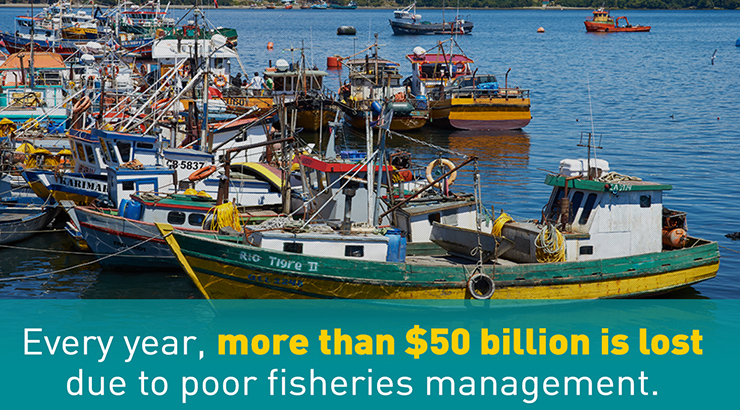Investing in Sustainable Global Fisheries: Going from Theory to Practice

In the final installment of our series featuring Vibrant Oceans partners and ahead of next week’s Our Ocean conference in Chile, we’ve asked Encourage Capital’s Jason Scott to share information on their new Investment Blueprints for sustainable global fisheries. Read past posts by Rare and Oceana.
What does it mean to invest in fisheries for social and environmental impact? At Encourage Capital we believe the key to answering this question is simple: Begin with the impact. Perhaps the best way to explain what this means is to provide an example:
Over the last three years, Encourage Capital has been working with Bloomberg Philanthropies’ Vibrant Oceans Initiative and The Rockefeller Foundation to develop investment strategies that use private capital to help protect and restore global fisheries while improving the livelihoods of the millions of people who rely on those fisheries. To do this, we teamed up with fisheries experts at two non-governmental organizations, Oceana and Rare, to better understand how we might address these problems in both small- and large-scale fisheries at a whole system scale. Following initial research, we focused on three key countries: Chile, Brazil and the Philippines. Working with these organizations and local partners, we designed several investment blueprints that offer approaches to delivering positive investment returns, support local livelihoods, and restore marine ecosystems – all by recovering a specific fishery.
Today, Encourage is releasing two blueprints focusing on iconic fisheries in Chile, in celebration of the Our Ocean conference taking place there next week. The goal is to look at real fisheries, and real problems, to illustrate the kinds of analyses and projects that could lead to positive change – and financial returns – globally.
One example is our model investment strategy to help recover the common hake (Merluza) in Chile, one of the most important fisheries in that country. This fish was one of the mainstays of both industrial and small-scale fishing fleets. However, the fishery (like so many others around the world) has collapsed to the point where quotas were cut in half. Where it once produced nearly 1.5 million tons of fish, it is now expected to produce one-fifth of that amount. The economic, environmental, and social impacts of that collapse at that scale are hard to exaggerate: thousands of people have lost their livelihoods, entire businesses have disappeared, and hundreds of fishermen have turned to illegal fishing to make ends meet.
This is not unique – and neither are the potential investment solutions. In talking to local fishermen, the fishing industry, local government officials, and NGOs, we discovered that although Chile has a robust set of fishing laws, the hake fishery is still being overfished and is plagued by illegal fishing. To make matters worse, it is believed that climate change has in part led to a boom in a natural predator of the hake, the giant squid. Additionally, the supply chain is highly inefficient with many intermediaries (most adding little or no value) between the ports and point of sale. Taken together, a collapse of that magnitude in a fractured hake fishing industry meant that fishers at the dock were getting one tenth, or less, of what that same fish, with no processing, was fetching in the markets of Santiago. To support their families, fishers are forced to fish more and more, which means less fish and more work each season. In short, fishers are spending more and making less money.
After mapping the economic, environmental and social ecosystem of this fishery, we were convinced that there could be a compelling investment opportunity in turning the fishery around and capturing more value for local fishers. And those lessons are transferrable. The details change, and the models need to be customized, but we know what interventions can make a difference.
Encourage’s investment blueprints show how solutions can be laid out in ways that investors can actually act on them in the current environment. For example, for the hake fishery in Chile, we designed an impact investment strategy that includes:
- Investing in processing and value-added capabilities for artisanal fishermen in return for better management of the fishery (catching less fish that they can sell at a higher value) and some environmental protections.
- Investing in transitioning some fishermen to catch and sell giant squid. This would both take some predation pressure off the hake, and also provide another source of revenue for struggling fishermen.
- Investing in a significant portion of the hake quota in Chile. Industrial fishermen have indicated willingness to sell some of their quota given the fishery decline, much in the way distressed assets are sold in other sectors.
Together, these investments would essentially fund implementation of comprehensive fishery management improvements across the Chilean hake fishery. These investment strategies are intended to not only generate a financial return for investors, but also a tangible impact.
The Chilean strategies are available today at www.investinvibrantoceans.org, with the Brazilian and Philippines strategies to follow this fall. We hope these will serve as models for others around the world to analyze and design fisheries investments that increase sustainability, improve the lives of fishers, and deliver financial returns.